| Home | Nature Weekly Index |
27 December 2015 | Spittlebugs | Froghoppers | Cercopoidea | Machaerotidae |
.jpg) The froghoppers belong to the superfamily Cercopoidea. This superfamily is further divided into 5 families,
namely Aphrophoridae, Cercopidae, Clastopteridae, Epipygidae and Machaerotidae. This group of insect is best
known for the nymph stage, which produces a cover of saliva-like foam. Hence, they are also known commonly as
spittlebugs. However, one of the family in the group, Machaerotidae, is known as the
tube spittlebugs because the nymphs live in
calcareous tubes instead of the saliva-like foam.
The froghoppers belong to the superfamily Cercopoidea. This superfamily is further divided into 5 families,
namely Aphrophoridae, Cercopidae, Clastopteridae, Epipygidae and Machaerotidae. This group of insect is best
known for the nymph stage, which produces a cover of saliva-like foam. Hence, they are also known commonly as
spittlebugs. However, one of the family in the group, Machaerotidae, is known as the
tube spittlebugs because the nymphs live in
calcareous tubes instead of the saliva-like foam.
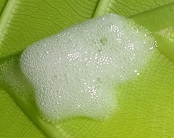
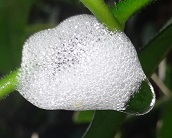 For quite a while, I had named this brownish-white spittlebug as Philaenus leucophthalmus
(Meadow Spittlebug). I received a note this week from Les Day
that Meadow Spittlebug is not supposed to inhabit this region. Though my spittlebug looked similar to Meadow
Spittlebug, it is likely to be another species. I made another attempt to search for its identity but nothing
came near. To most people, spittlebug is not likely to be a very interesting insect. It is therefore not
surprising that there are barely any information or report on its status in Singapore.
For quite a while, I had named this brownish-white spittlebug as Philaenus leucophthalmus
(Meadow Spittlebug). I received a note this week from Les Day
that Meadow Spittlebug is not supposed to inhabit this region. Though my spittlebug looked similar to Meadow
Spittlebug, it is likely to be another species. I made another attempt to search for its identity but nothing
came near. To most people, spittlebug is not likely to be a very interesting insect. It is therefore not
surprising that there are barely any information or report on its status in Singapore.
.jpg) Another piece of information that Les Day shared was on one of my unknown treehopper picture. Apparently, that should
not be a treehopper but should instead be a tube spittlebug. The unique spine on its back had led me to group
it under the treehopper. The clue that it was indeed a tube spittlebug was the origin of the spine. Treehopper's
spine typically originated from the pronotum while the spine for tube spitterbug originated from the scutellum.
Another piece of information that Les Day shared was on one of my unknown treehopper picture. Apparently, that should
not be a treehopper but should instead be a tube spittlebug. The unique spine on its back had led me to group
it under the treehopper. The clue that it was indeed a tube spittlebug was the origin of the spine. Treehopper's
spine typically originated from the pronotum while the spine for tube spitterbug originated from the scutellum.
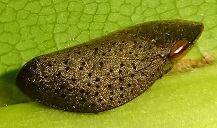
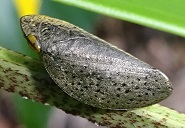 With this topic fresh on my mind, I went to a nearby park on Christmas day with the aim to look out for
spittlebug. Interestingly, the only type of spittlebug in that park was this black-spotted gold colour species.
There was no sign of the brownish-white spittlebug, which I had spotted
a large colony in another park in May. Though the 2 black-spotted
spitterbugs in the 2 pictures looked different in colour, they should be the same species. The colour variation
was probably due to the camera flash,
With this topic fresh on my mind, I went to a nearby park on Christmas day with the aim to look out for
spittlebug. Interestingly, the only type of spittlebug in that park was this black-spotted gold colour species.
There was no sign of the brownish-white spittlebug, which I had spotted
a large colony in another park in May. Though the 2 black-spotted
spitterbugs in the 2 pictures looked different in colour, they should be the same species. The colour variation
was probably due to the camera flash,
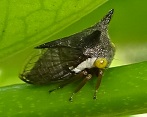
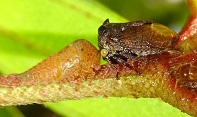 I did find the real
treehoppers (Family: Membracidae)
at the usual location. They tend to gather on the slender branches of some plants. Their all-time favourite host
plant was
Straits Rhododendron (Melastoma malabathricum),
where both adults and nymphs gathered, usually protected by army of ants. Another plant in this park that this
treehopper favoured was the
Limau Hantu (Suregada multiflora).
I did find the real
treehoppers (Family: Membracidae)
at the usual location. They tend to gather on the slender branches of some plants. Their all-time favourite host
plant was
Straits Rhododendron (Melastoma malabathricum),
where both adults and nymphs gathered, usually protected by army of ants. Another plant in this park that this
treehopper favoured was the
Limau Hantu (Suregada multiflora).
It was hard to spot spittlebugs in the wild. It size is quite small, around the size of a peanut. The treehopper is even smaller in size. While sticking my head around looking for spittlebug, I had encountered quite a few interesting creatures which I will share next week.
Update: 4 June 2016
Les had kindly written to me again in May 2016 to share with me the identity of this spittlebug (Ptyelinellus praefractus) which he had uncovered and the source indicated that it was found in Malaysia.